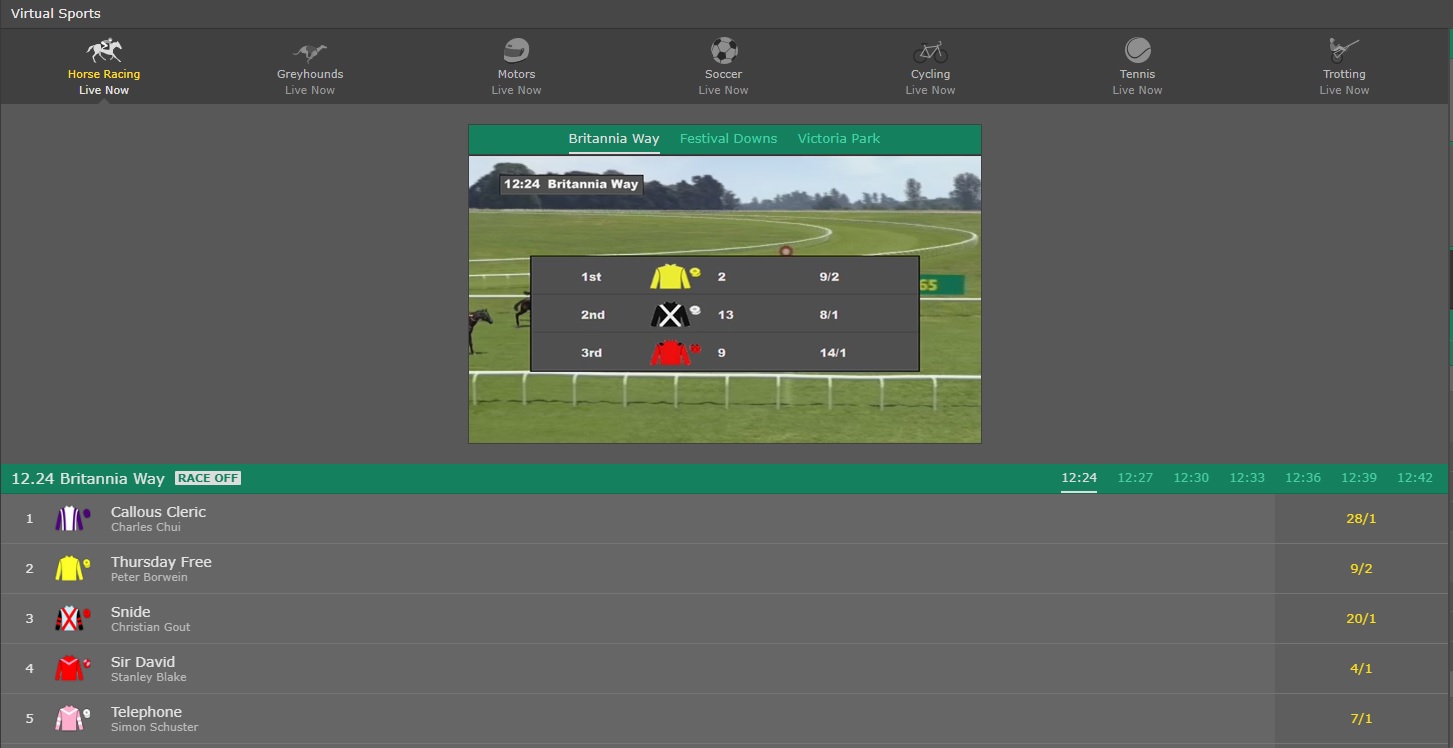Ever since the days when you could bet 10p on the winner of a mechanized horse race in the amusement arcades, betting on pretending races for real money has been appealing to many. While some horseracing punters will peruse form, breeding, the jockey and trainer, the going and a myriad of other factors before placing their bets, there are a significant number of punters who just want to place bets and have the results delivered quickly.
the jockey and trainer, the going and a myriad of other factors before placing their bets, there are a significant number of punters who just want to place bets and have the results delivered quickly.
That is precisely what Bet365’s Virtual Horse racing provides customers with and in this article, we are going to look at all the different aspects of this Virtual offering. We will investigate what markets you can bet on, the range of odds available, number of runners and we’ll even take a straw poll of races to see how often the favourite wins the event to see if we can formulate some form of basic strategy.
So let’s begin at the start with a review of exactly what Virtual Horse racing Bet365 offers.
Virtual Horse Racing at Bet365 Sport
When you load up the Virtual Horse racing console at Bet365 you have a choice of three different venues. They are:
- Britannia Way (flat racing)
- Festival Downs (flat racing)
- Victoria Park (Jumps)
Bet365 has staggered the start time of each of these races so you can flick between them to bet on more races and have results decided more quickly if you prefer to bet that way. If you prefer to bet on a particular event, then each race takes 3 minutes to complete, that includes 1 min and 30 seconds of time to place your bets.
Placing your bets
When you click on a Virtual Race to place your bets then what you will see is a list of the runners and riders for that race, complete with the odds to win on that selection. You have a choice of four different bets you can make on a Virtual Race at Bet365 Sport.
- Win Bet – This is a bet on the horse selected winning the race
- Each Way Bet – This is a bet on the horse selected finishing in a paid place. The number of paid places on offer for each race is displayed and is dependent on the number of runners in the race.
- Forecast Bet – This is a bet on which horses will finish 1-2 in the race. You can also select the “Any” option to allow you more flexibility on which position your two selections finish in, although there will be more lines to cover with this bet (two in total), so your total bet will be 2x your Unit Stake.
- Tricast Bet – A Tricast bet is a bet on which horses will finish 1-2-3 in the race. Similar to the Forecast bet, you can select the “Any” option for greater flexibility in where your selections finish. This means you have six lines to cover with this bet and as such, your total bet will be 6x your unit stake.
To add the selected bet to your slip, simply click on the Odds for your selection for Win or Each Way bets and this adds your bet to the slip. For Forecast and Tricast bets, simply click on where you think the horse will finish (or the Any button) for two horses for Forecast and three for Tricasts. Then add it to your bet slip and the bet will appear here.
You then place your bet as you would any other bet you make with Bet365 Sport.
You must complete placing your bets within the time allotted for bets on this race. The timer runs down as the race start time draws near and you must place your bets within this time otherwise the race will start and your bets will not be placed.
The Race Itself
When the betting period ends, then the race itself will begin. What you have here is the representation of the race using computer graphics and rudimentary commentary which will indicate to you which of the horses (which are always identified by their numbers) are doing well or poorly in the race.
computer graphics and rudimentary commentary which will indicate to you which of the horses (which are always identified by their numbers) are doing well or poorly in the race.
The race is shown in its entirety and lasts about 30 seconds. You can see a representation on the screen of the horses racing and the position of the horses in the top three is shown by an indicator bar at the bottom of the screen for clarity.
Once the race has been completed, then the result is announced and then a screen displaying the result, with the odds for each selection is shown for the remainder of the three minutes allocated for that race. Once three minutes is reached, the next race will begin with the betting phase.
When the result is officially confirmed, then any winnings owed to you based on the result and your selections will be made and your balance updated.
How do the jockeys and horses get their names?
Although not referred to in commentary, each of the numbered runners in a race is given a name and a jockey. These are selected from a large database of virtual jockeys and horse names and selected at random for each race.
Some of the horse names may be names of horses that have run in the past, but to avoid confusion, the company has taken care to try and not replicate the name of any horses currently running. Although as new racehorses are named and the database isn’t updated, this may not be the case for all bets.
What is the case however is that the name of the horse means nothing as there is no race history, breeding history or form attached to the horse. All you have to go on about whether to back it, is its odds.
If there is no race history, form or breeding history, how are odds worked out for each runner?
The odds for each selection are based on how much the horse is weighted favourably or unfavourably in the race compared to all the other opponents running. This allows the software to differentiate between which runner is more likely to win and thus create realistic odds for the race and each of the runners.
The software does take into account these weightings, so you should see favourites win their fair share of races as well as being places, but similarly there is enough variability built into the software to ensure that occasionally you’ll get longer odds winners, together with a smattering of medium odds winners.
That is the theory, but how does this work out in virtual reality? Well the only way to do this is to test the software, so that’s what we did over 20 races. The results of those 20 races are outlined in the table below:
| Race Number | Number of Winner & Odds | Runner Up & Odds | Third & Odds | No of Runners |
| 1 | 8 – 11/4 fav | 9 – 9/1 | 10 – 12/1 | 12 |
| 2 | 1 – 16/1 | 5 – 7/1 | 3 12/5 fav | 9 |
| 3 | 5 – 11/5 fav | 3 – 12/1 | 1 – 25/1 | 9 |
| 4 | 8 – 7/1 | 7 – 9/1 | 3 – 9/4 fav | 9 |
| 5 | 10 – 4/1 | 8 – 15/2 | 9 – 40/1 | 14 |
| 6 | 6 – 9/1 | 4 – 50/1 | 1 – 4/1 | 8 |
| 7 | 15 – 5/1 | 6 – 22/1 | 9 – 9/1 | 15 |
| 8 | 4 – 28/1 | 7 – 7/1 | 8 – 11/1 | 11 |
| 9 | 3 – 3/1 J-Fav | 4 – 7/1 | 5 – 9/1 | 8 |
| 10 | 8 – 12/1 | 6 – 10/1 | 2 – 11/5 fav | 10 |
| 11 | 8 – 10/1 | 9 – 8/1 | 4 – 9/4 fav | 10 |
| 12 | 4 – 13/5 fav | 7 – 9/2 | 3 – 28/1 | 12 |
| 13 | 1 – 13/5 fav | 3 – 7/2 | 2 – 7/1 | 8 |
| 14 | 4 – 9/1 | 5 – 28/1 | 9 – 10/3 fav | 12 |
| 15 | 5 – 9/2 fav | 14 – 5/1 | 10 – 14/1 | 15 |
| 16 | 7 – 10/1 | 2 – 9/1 | 11 – 11/4 fav | 12 |
| 17 | 11 – 12/1 | 9 – 9/4 fav | 5 – 20/1 | 15 |
| 18 | 8 – 8/1 | 6 – 13/2 | 5 – 16/1 | 10 |
| 19 | 5 – 20/1 | 7 – 4/1 | 4 -13/2 | 9 |
| 20 | 7 – 13/2 | 6 – 16/1 | 4 – 22/1 | 14 |
It should be noted that while this data does show that favourites do win a fair number of races, there is enough variance within the software to ensure that you can’t predict results. Furthermore, we should add that this is only a small sample of 20 races and for a bigger and more scientific analysis, results of thousands of races would need to be compared.
As you can see, out of the 20 races, the favourite won the race on six occasions and was placed second once and third a further six times. The shortest price winner was 11/5, with the longest price winner 28/1. Horse number eight won five of the 20 races listed, while horses numbered 2 and 3 (out of the minimum eight runners in all races), did not win a single race.
Can we devise a strategy for betting on Virtual Racing at Bet365?
Based on this small sample, I would be very wary of devising a strategy and keeping to it rigidly, but what we can see are the emergence of some trends, namely that favourites tend to win around 30% of the races run, that there are long odds winners (20/1 or greater) approximately once in every 10 races and that certain numbers of horses seem to produce more winners than others.






